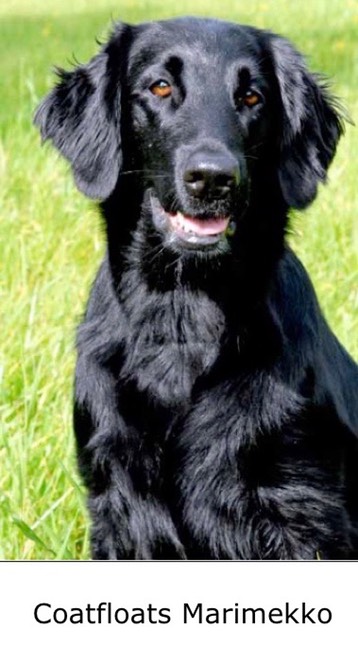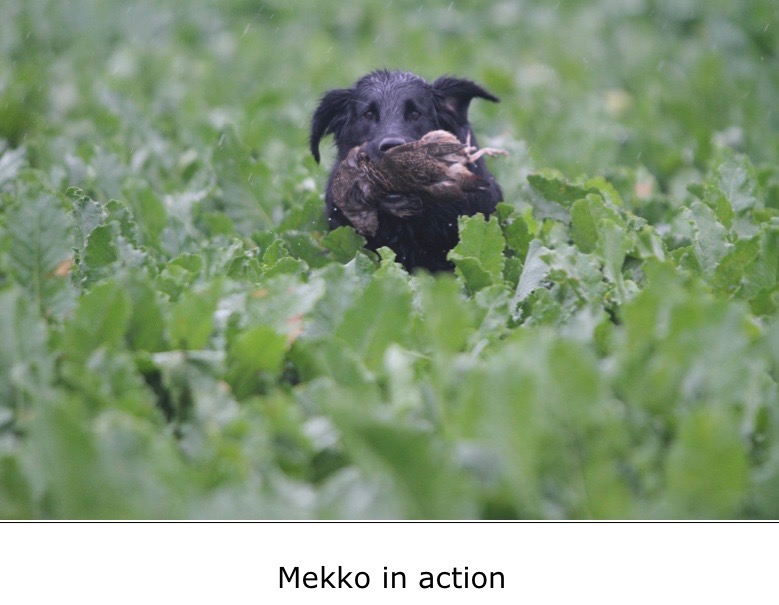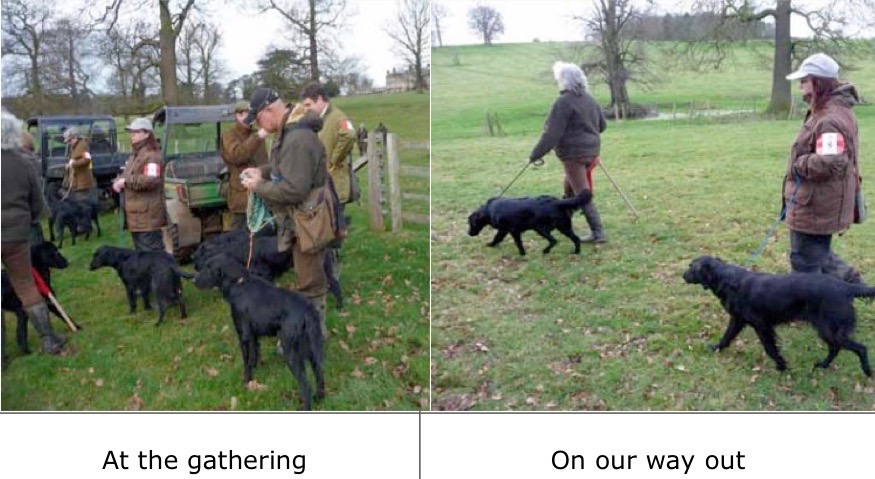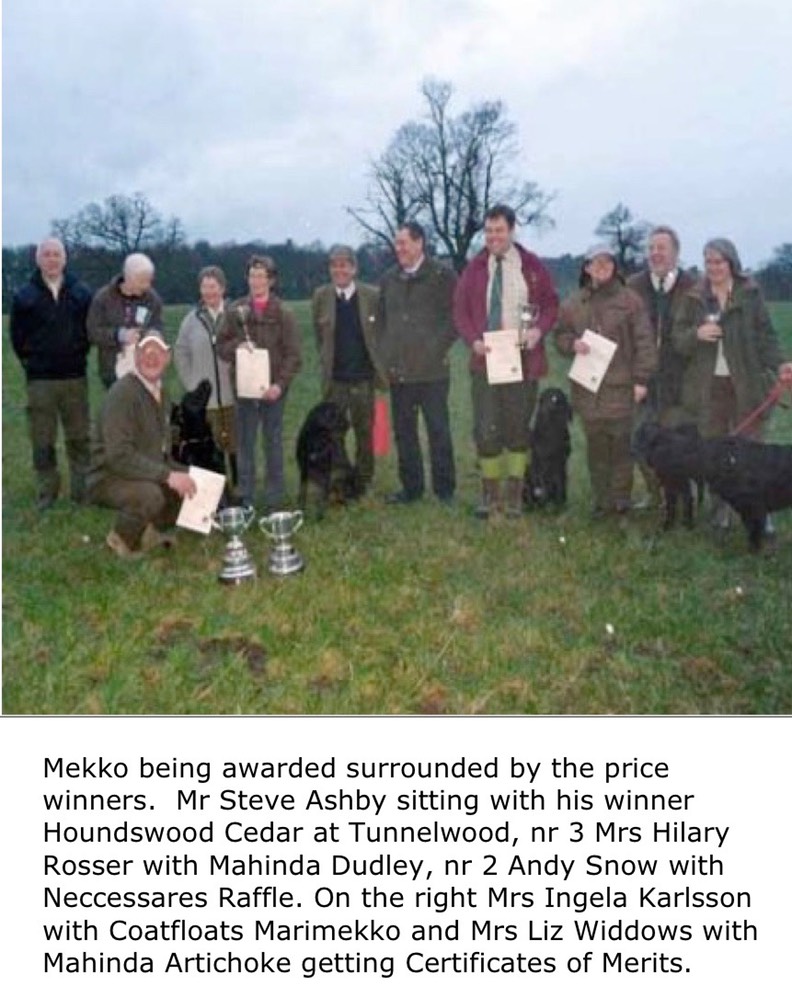(Intro by Ingemar
Borelius
Writings about Mekko by Ingela Karlsson)
Connections have been strong over the years between the British and the Nordic
Flatcoat worlds with continuous British imports as well as training courses
provided by British trainers. During the last decade Swedish show dogs have
shown their qualities going to the top at the larger British shows and proved
their values at stud. But for some reason practically no Nordic dogs have been
entered at British Field Trials, just a few Flatcoats, partially based on
Nordic show lines have been entered and no dogs from the leading Nordic working
lines have been started or used on the British working lines in Britain.
It’s a fascinating fact however that the dog Feather In My Cap At Higgscroft (Tygwyn Tawny Porthos x Almanza Bag Lady) won the Riverside Cup in 2017 and I believe it might indicate at least that dual purpose qualities have been kept to some extent in the Nordic show lines. It’s notable as well that dogs from Nordic show or dual-purpose lines appear behind FT awarded dogs like Walnutfarm Nuala (Carpet Flyer's Champion No 3 of Silkman's Castle x Walnutfarm Nemesia), her sire Carpet Flyer's Champion No.3 of Silkmans Castle (Micawbers Silverground Carpet Flyer x A No 13 of Silkman’s Castle), Varingo Nedrill Trigon (Lhaxy's Yatzy at Exclyst x Reltub of Varingo) and Cath's Silver Tuva (NH Ch Pumpans Silver Doctor x Hinnared's Highly).
I strongly believe that a tighter cross border cooperation could add value to the work oriented Flatcoat breeding all around the world. Knowing how narrow Flatcoat lines are in all countries and how the limited genepool affects health and longevity it’s of utmost importance that outcross options are used to a larger extent. I don’t question that linebreeding to the best workers is a necessary and most useful tool to stabilise working features in a targeted breeding program. If such a program could be used to strengthen the influence from first class dogs with more unique DNA profiles it could be beneficial for a broader gene pool and consequently for an improved health and longevity in the breed.
The reasoning behind the workingflatcoatedretriever.com homepage is to distribute fact based information about working Flatcoats in different countries and to promote an increased cross border cooperation.
I’m quite sure that DNA studies, if laid out at a somewhat larger scale, will show quite significant differences between the Nordic and British gene pools. That is due to the fact that the Nordic lines were strongly established during the nineteen sixties from a pool of dogs quite unlike those that dominated the British foundation stock. Most dogs in the Nordics, no matter if you look at the show/dual purpose or working lines, are linebred numerous times on that foundation stock. And with few exceptions it’s obvious that the majority of winners at Field Trials or Cold Game tests in the Nordics are mainly bred from that local Nordic stock.
Could it be so that the best Nordic dogs have got a reputation for being too hot to fit in with British trials? I agree that it requires tremendous drive and perseverance to succeed at the cold game tests over here. A dog won’t go to the top if it hasn’t the capability to work independently and efficiently on the “free search”. But it wouldn’t reach champion status if it can’t be handled with precision over long distances on land and in water. And it wouldn’t challenge the best Labradors over here at an A-test (Field Trial) without being rock steady under hot conditions.
Swedish Flatcoats like Friia Agnar Windy (bred in DK), being awarded 3: rd best dog overall and the best minor breed at the CLA/The Aigle World Challenge, at Belvoir Castle in 2005, Flatterhaft Fay Crocker awarded with a certificate for being the best Euro dog at the Euro Challenge at the Hatfield House Game Fair in 2017 and Coatfloats Marimekko, getting a Certificate of Merit at the FCRS Open Stake in 2013 have shown that the top performing Swedish dogs can match the best on British grounds.
The Flatcoat bitch Coatfloats Marimekko (Reltub Black Velvet x Coatfloats Enjoy Gucci Megaflyer), owned and handled by Ms. Ingela Karlsson, was one of the most winning Nordic working Flatcoats between 2008 – 2016. She is probably the first and only Nordic working Flatcoat having entered a British Field Trial until now.
SEJCH NOJCH DINJCH DKBRCH NORDJCH DKWTCH FTAW Coatfloats Marimekko
(The first (J CH) titles mean that Mekko has gained champion titles on Cold Game tests in all the Nordic countries which also entitles her for the Nordic Champion title. DKWTCH means that she has won three official any variety Working Tests in Denmark making her a DK WT Champion. FTAW is an unofficial but widely used title that means that she’s got an official award from a British Field Trial)
It was thanks to my friend Ann-Lena Wendt (Svartalwen) that I got Mekko. I was looking for a dog with the capacity to compete at trials and tests. She informed me about a litter at the Coatfloat kennel, I talked to Tina and Björn Weberg and when I returned home with the pup in 2006 I thought I’ve got a golden nugget. Mekko, as I called her, turned out to be a very calm and friendly little pup but when I started to train her I would lie if I called it a success. The first two and a half years were quite discouraging, and I questioned more than once if that bitch would be of any value as a worker and if I should keep her. I appreciated doing some obedience and utility work at that time and my previous Flatcoat responded quickly and with a constant focus on me at heel. But to my great disappointment Mekko looked as if she wanted to throw up when she was watching the training field. We had a few prices in obedience classes but at the end I realised I had to finish what Mekko considered to be my “green grass terror” activity!

In 2008 we entered a Beginners Class Cold Game test with a 1:st price and the following spring an Open Class with Mekko being awarded the best dog at the test. At our second start in Open Class she exposed what I would like to call here “donkey gene”! I sent here on a line for a blind and on her way out a distraction was thrown at the side. She stopped perfectly on my command, but I realised soon that she wouldn’t go for the blind no matter what. But as long as the judge didn’t ask me to call her up I was determined not to let her go for the wrong one. We succeeded at the end and the judge praised me with the words; “it was a lot of hard work for that little rabbit” and gave us a 2: nd price.
The next time we went to Denmark and even this time I got a bit of a hiccup! When Mekko was about to retrieve a double mark in water, I sent her for the last one first as I always do. I sent her to the right, but to my great surprise she went on a straight line to the reeds nearby and turned back with a pigeon in style. As it showed the thrower had dropped a bird on his way out by mistake unseen for me and the judge but obviously Mekko had marked it. At the end she had a 1:st price for doing a god job all through the test.
Now it was time to train for the Elite Class but Mekko couldn’t easily stop believing that all the “disturbance retrieves were for me”. Maybe that goes with one of her strong sides being a dog that never gives up. No matter how many times I stopped her she was the happiest dog when being sent again. It was about convincing her that I was right all the time, and it obviously worked in the end.
We made a journey to Norway for the first Elite Class test. It was a walk-up test with six dogs walking in line over a mire where holes were deep, and we had to crawl to get through. It ended with a drive where the dogs were sitting at the side of a lake. It was a bit of a challenge, but I like the Norwegian tests with all these surprises and it ended with a 3: rd price. I realised that my dog wasn’t that bad after all but needing some training to manage that kind of conditions. A few weeks later we went to a Winner Class Cold Game Test in Denmark, which is about the same as an Elite Class test in the other Nordic countries, with the difference that no quality prices are awarded. There is a winner, a 2: nd, 3: rd and 4:th winner, a Certificate for the winner and a possible Certificate Quality (CK) for the other awarded dogs, if they are up to the required standard. Mekko was awarded a 2: nd price but with no CK. Now I stopped grumbling over my inert dog. It took some time but at the end she turned out to be quite god.

In October the same season she was entered at three Elite Classes in Sweden over eight days being awarded 1: sts at all occasions. Two weeks later she was about to enter, the so called “Praktiskt Jaktprov” (“Practical Gundog Test”) at an ordinary shot, which is about proving that your dog is a fully skilled gundog all through a shot. At least two dogs are jointly tested, and a panel judge is following alongside all through the test. The day started in nice weather but after a while winds were blowing hard with wet snow. Now I wasn’t only nervous but wet all through and freezing “like a dog”. At the last drive I just thought that I couldn’t care less about the test, I just wanted to get away from the cold. But when Mekko got the qualifier I totally forgot about the weather. I was the happiest person on earth and when the year ended Mekko was awarded for being the Swedish working Flatcoat of the year 2009. At three years of age she had passed the Open and Elite Classes in great style and gained the Swedish “Jakt” Champion title.
The next year had a very depressing start for me. Mekko was supposed to have her first litter but it ended with an infection and she had her uterus removed. There wouldn’t be any pups out of my star and I felt that life was hard and unfair to me. But a friend of mine assured that everything in life has a meaning and maybe that’s how it is because 2010 turned out to be another successful year. Mekko won two Danish B-tests (Cold Game tests) with Certificates and she had a 1:st price at a Norwegian B-test giving her the NO J Ch title. We made a start at a challenging International Working Test in Norway doing a decent job but being out of the prices and she was 6:th best dog at the Norwegian any variety Retriever championship on cold game although she failed in the final round.
That year in October we made our debut at a Danish A-test, being the Nordic name for a proper British style Field Trial. Conditions were quite challenging with hard winds and we were out of the awards jointly with three other dogs when the judge found the bird. We had another try at a Swedish any variety A-test gaining a 3:rd quality price. The year after Mekko was 2:nd winner with a CK at a Danish A-test and due to the fact that the winner was a Champion already Mekko received the Certificate as well making her a Danish “Bruks Champion” (the equivalent of a Swedish “Jakt Champion), and as a consequence she gained the Nordic “Jakt” Champion title (NORD J CH).
Mekko won three Danish any variety Working tests in Denmark in 2012 and 2013 making her a Danish WT Champion. She conquered one 2: nd price and two 3: rd prices at Swedish A-tests. She was a part of the winning Swedish team at the Nordic Flatcoat Championship for seven consecutive years and she won the individual competition in 2011 and 2015 which probably is a quite unbeatable record. Not a bad dog after all!
The Flatcoated Retriever Society (FCRS) Open stake in 2013
I believe it was the British Flatcoat breeders/trainers David and Roz Bellamy and two Swedish friends of theirs who inspired me to make the journey to Britain and to enter the FCRS Open Field Trial. I sent an application and when the list of entries was published my name was there. David Bellamy, being the FCRS FT secretary at that time, recommended a suitable lodging nearby. But when I realised there were two Falcon Inn within a 20-km distance from the grounds, and I’d booked the wrong one, I was happy to find there was a room left at the proper place. Roz Bellamy stated that “it’s snowing like crazy over here at the moment” and all the way down to Britain roads were covered with snow, which was quite unbelievable. But I was glad to hear from Roz that it was supposed to rain at the time for the trial and when we arrived in Britain it was wet but free from snow.
When me and my friend Karin arrived at the Falcon in Long Whatton we were warmly welcomed. The Pub was filled with Flatcoat-enthusiasts and their dogs and at the large fields behind we were free to exercise our dogs. The Pub-owner kindly offered a guided tour to the grounds, the overall service was splendid with a nice room and food and drinks were excellent. What more could we ask for? Is this what it’s like to be in Britain?
At the shooting grounds the day after I was approached by one of the competitors asking about my dog. “How would you describe your dog from a British view point?” It wasn’t that easy to respond but I tried to be as pedagogical as possible. She’s a bit on her toes, but being very obedient and an excellent game finder. The response I had to my surprise was that “all Swedish Flatcoats are on the toes” and that’s how it is!!

The draw was already made, and I got number 8 in a team of 11 dogs. Dogs with odd numbers should go with Phil Garton and Jennifer Hay, and those with even numbers with Richard Beckerleg and Gordon Hay. We started to walk towards the big fields nearby and my nerves were setting in. The line was settled with a couple of guns in the line. I realised that the firsts pheasants probably would fall on the open lawn close to the line which was a bit of a night mare for me, and indeed it fell. A number of pheasants and a partridge went down around the line. Could you imagine the feeling when you’re just about putting the lead on your over excited dog starting the long journey home and the needed steadiness training. I watched the other’s placid dogs and I remember that I started to think if my British competitor had seen my bitch before? When the drive was over all handlers, except the first four, were asked to put the lead on and I could feel the disappointment from my little bitch.
The handlers were sending their dogs on a line over long distances and all the birds nearby were left aside to be picked from another starting point. Each dog was asked to pick two birds each before the next team of handlers was asked to join the line. Mekko made a good performance retrieving a pair of pheasants. At the first drive one of the contestants had to leave due to poor performance on one of the birds.
We went off for the next drive and settled the line with a couple of guns. Heavy winds were coming in after some time. When the drive was over the first dog was sent on a winged bird, but it couldn’t find the bird being a bit disobedient. Another dog was called in and made a proper piece of work, but it failed as well. Now the judges went out to see if they could find the bird. But despite the fact that the bird wasn’t found the first dog was asked to leave according to the principle of “first dog down”! It’s based on a reasoning that the first dog at least had a reasonably good chance to find the bird. But behind the line there were diverging views if the dog was sent in proper time or not.
Now it was my turn. A bird was down close to a wooded area and where did Mekko want to go? To the forest of course! A decent retrieve in intense winds that could have been a bit straighter if I was to judge. But the spectators behind agreed that it was a good retrieve taking the winds into consideration.
When the third drive was about to start winds were a bit too strong. It would probably affect the birds and the shooting conditions negatively so new plans were to be made. During the waiting time I had a lot of time to talk to the other handlers and I praised their placid dogs. It was no doubt that their dogs were rock steady but Mekko wasn’t. They told me that they spent most of the time training their dogs not to retrieve and considering the conditions at the trial it was obviously a wise decision.
The third drive wasn’t started until the lunch was over. There were seven remaining dogs, one dog had been put out for a so-called B-retrieve, which wasn’t good enough, another dog from the other team of dogs was put out for unknown reasons. Mekko had performed surprisingly well and was still in the game.
A long walk took us to the fourth drive that was supposed to be the last one. Even this time we walked over open rolling fields. Conditions became a bit more turbulent, judges seemed to discuss more, and birds were given faster to the competitors. I was called off the line to be prepared for a winged pheasant from the other team. When I arrived there, I was called back to direct Mekko to a running pheasant on its way to a brushwood along a deep ditch. My friend and the other spectators was in line with the brushwood having a full view of the area, but we weren’t. I could see the pheasant but Mekko didn’t. I was asked to send her in parallel to a couple of dead pheasants with winds blowing in her direction, towards the brushwood were no game had fallen during the drive.
But I must say that training makes perfect. If we’d been there a year before we would have failed. Now I could get her down there with some persuasion, but it took some time and one of the judges went down there to see what was going on. After a while Mekko got up, down again and after some time she got up again with the pheasant. At that time, I almost had a heart attack! Isn’t it surprising that were doing it freely! But it was obvious that the crowd enjoyed watching a bit of excellent retriever work and my friend Karin thanked someone for listening to here prayers.
Judges started to debate again and the five us still being in the game were starting to discuss who could be the winner. No one said anyone’s name and it was obviously so that the five remaining dogs had performed equally well, retrieving the same amount of birds, with a similar severity degree. It was easy to conclude that margins would be small. But it was getting darker and there was no time for a fifth drive. It was a relief to be sent back on a narrow tractor trailer and it was time to be informed about the results. Lord Crawshaw, the owner of the Whatton Hall shot, executed the award ceremony. The winner was Houndswood Cedar at Tunnelwood, owned and handled by Mr Steve Ashby, second dog was Neccessares Raffle, owned and handled by Mr Andy Snow, third dog was Mahinda Dudley owned and handled by Mrs Hilary Rosser, Certificates of Merit (CoM) were given to Mahinda Artichocke owned and handled by Mrs Liz Widdows and to Coatfloats Marimekko, owned and handled by me, giving her the informal British “title” FTA (Field Trial Award).

I’m
so glad that I made the trip, what an experience to be judged by a British
judge on British grounds. It was a great experience to expose a Swedish bitch,
being on the toes yes, but being as obedient and easy handled as all the other
dogs. That was a great time and I will absolutely go their again with another god
dog. I do hope that I could inspire other Nordic Flatcoat enthusiasts to make
the journey. Our best dogs are good enough for sure to perform a decent job as
long as we put enough efforts to make them absolutely steady.